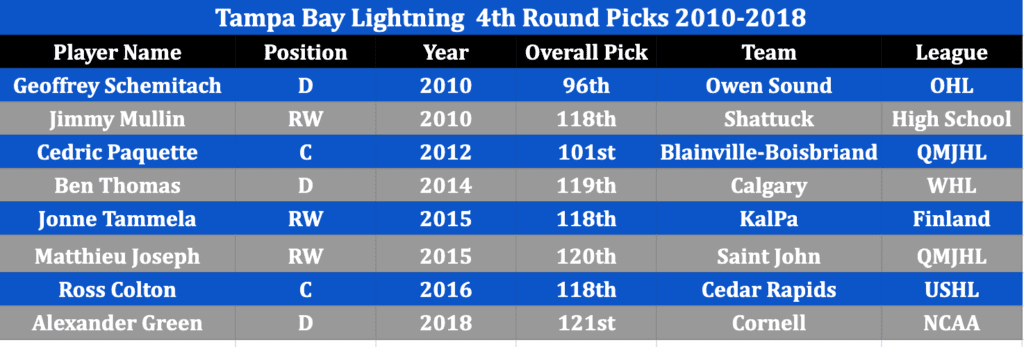Detroit Red Wings
Anatomy of the Yzerplan: Red Wings Draft Compared to Tampa Bay’s

The Detroit Red Wings have benefitted from the the addition of Steve Yzerman when it comes to recent drafts. Hitting on Moritz Seider, Lucas Raymond, and quite possibly Simon Edvinsson will accelerate Detroit even further out of the rebuild.
This doesn’t even factor in the later round picks he’s made, many of whom are shining on the world stage during the World Juniors.
But were the results similar in Tampa? Further, did Yzerman replicate his drafting tendencies in Tampa? Pivot? Or completely change course?
The fourth piece of the Anatomy of the Yzerplan series looks right at that. Specifically:
- A look at every round of the draft going back to his first draft in 2010
- A breakdown percentage wise by position and how it correlates with his drafts in Detroit
- A breakdown percentage wise by league and how it correlates with his drafts in Detroit
- Final analysis
Everyone knows that Nikita Kucherov and Andrei Vasilevskiy stand out from Yzerman drafts. But do the results hold up the further you look at his entire body of work?
Round by Round Analysis of Yzerman’s Work in Tampa
Yzerman took over Tampa Bay in May 2010. When he finally stepped to the stage during the 2010 NHL Draft, it was odd for many Red Wings fans to see him representing another team. His first pick? Brett Connelly.
So how else does it break down across the first round during his tenure from 2010-2018?

So here’s the interesting part. Only one player is an international selection and that is Vasilevskiy, who was in the same league as recent Red Wings draft pick Dimitri Buchelnikov. As opposed to the 80% clip of players Yzerman drafted in the first round with Detroit, a whopping 87.5% of Yzerman’s Tampa picks were Canadian junior players.
His drafting in Detroit is a 180 degree turn away from his time in Tampa, where Yzerman spent high picks solely on players in international leagues.
What about the second round? Well, it’s more of the same. Of the 10 picks Yzerman had, 60% came from the CHL. Kucherov also hailed from the MHL, and was a home run pick who’s played a huge role in the success in Tampa.

A few names look familiar but not exactly screaming second round. But selections by league stay pretty steady in the third round.

Gudas, Point, and Cirelli stand out immediately, with Point being the absolute heist of the round’s selections. Again, the Canadian Juniors reign supreme, hauling in 78% of the picks. Yzerman goes back to the Russian Juniors league. More importantly, in the first three rounds of the draft, Yzerman hasn’t taken one player from the Swedish leagues.

It’s a bit less, yet the CHL still holds the majority of selections in the round with four. Yzerman is more diverse with his selections, taking players from high school, the NCAA, and overseas. The USHL is also represented, a league he hasn’t been shy about taking players from with Detroit. Paquette, Joseph, and Colton all are north of the 99 games played metric courtesy of Dobber’s Prospects.

The fifth round, then, is the first time Yzerman takes a Swedish junior while also drafting international prospects at a 60% clip here. The Russian juniors league crops up again, accounting for 40% of the picks in the round. Nesterov is the only one who goes above the 99 game threshold.

The sixth round is a massive haul in terms of the number of prospects. It’s almost exclusively North American drafting except for Sosunov, who hails from the MHL. An even 40% of the picks came from the USHL and CHL. Dotchin is the only one who exceeded the 99-game threshold.

Again, Yzerman went heavy in the seventh round like he did in the sixth, racking up 12 picks and plucking the playoff clutch Ondrej Palat in the process. Many of the players he took have played in the NHL to the tune of four out of 12. 33% of Yzerman’s picks made it to the NHL. Only Palat exceeded the 99 games while Gusev played 97.
Data Correlations with the Red Wings Draft By Position
Over the nine drafts that Yzerman conducted, he made 63 selections. This number might have been higher if it were not for the Lightning being in win-now mode since 2015. Below is a look at how Yzerman picked while in Tampa versus his time so far in Detroit.

A few notes:
- Yzerman has made 40 selections in Detroit against 63 in Tampa. The percentages show that with both organizations, he valued defensemen more than any other position. Detroit’s need was more pressing when he assumed the role, but it’s still a tell of his philosophy that over a third of his choices in Tampa were on the blue line.
- In Tampa, Yzerman chased after centers at a much higher clip. The gap between that and his defensemen choices is narrower as opposed to the nearly 20% gap in Detroit.
- Goalies and Right Wings were close in both organizations. Yzerman also took a goalie in the first round with both teams.
Data Correlations with the Red Wings Draft By League
This is where a seismic shift appears in Yzerman’s approach.

Of Note:
- Only one selection during Yzerman’s time in Tampa was from the SHL or one of its junior leagues. Conversely, nearly a third of his picks in Detroit have been from Sweden.
- A whopping 54 percent of his picks were from the Canadian juniors while at the helm in Tampa Bay. In Detroit, he’s selected a player from the OHL, WHL, or QMJHL 34 percent less of the time.
- He’s also chosen twice as many players proportionately from the USHL in Detroit than Tampa.
Final Thoughts
After spending nearly a decade in Tampa where the Lightning would spend the latter half of the decade in the conference finals and the Stanley Cup Final, Yzerman flipped the script when he arrived in Detroit in terms of drafting. Instead of going heavy in the junior leagues north of the border, he’s continued to pick from international talent.
Now, there could be a number of reasons for this. When beginning his career as a manager, Yzerman was heavily involved with the Canadian National Team, winning gold medals in both 2010 and 2014. Seeing that talent up close, perhaps it led to a confirmation bias that the best talent to build around was still coming from Canada.
Second, the scope of how he built in Tampa was different than Detroit. With the Red Wings, he was essentially starting over. Of the building blocks he had in Steven Stamkos and Victor Hedman, Yzerman truly only had that elite player in Dylan Larkin. The other “core” members were contributors, but hardly the foundational pieces like Stamkos or Hedman.
Finally, Yzerman ended up trading or not re-signing many of the very players he drafted from the Canadian junior leagues. Drouin comes to mind first, who he dealt for Mikhail Sergachev. While Sergachev was drafted by Windsor in the CHL Import draft, his career began in the MHL, a league Yzerman has chosen from often with both the Lightning and Red Wings.
How does it correlate? Of course, he won’t hold on to every player he selects. But in the first two rounds running the Red Wings, where it’s crucial to hit, Yzerman has all but changed his draft strategy. If you look below, his drafting by the first round is practically inverse with the Red Wings to what he did with the Lightning.

The second round looks pretty similar. Though lower percentages, he all but stays away from the three leagues.

As Yzerman’s tenure continues in Detroit, it will be fascinating to see if there’s a shift from this strategy as the team continues to improve. It will prove even more interesting if the success is as wild as Tampa’s or if it supersedes it.
Regardless, the Yzerplan in Detroit has a much different look than the one in Tampa Bay.
Previous Pieces from The Anatomy of the Yzerplan Series
- The Red Wings 1st round with Yzerman
- Analyzing the Red Wings Draft Rounds 3-7
- Ken Holland’s drafting strategy vs Yzerman’s
















